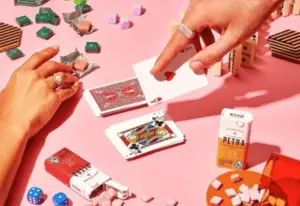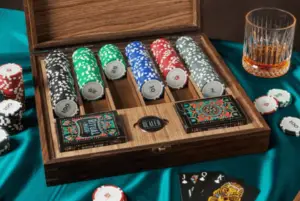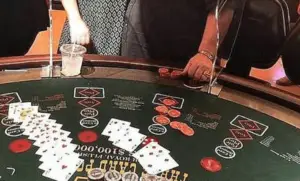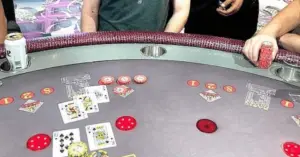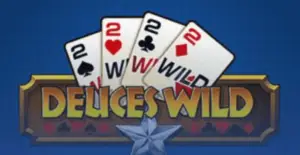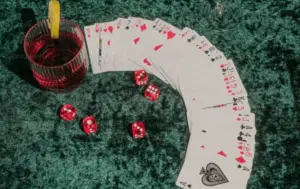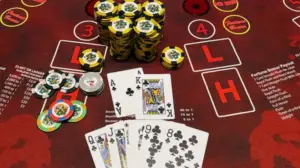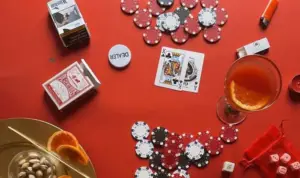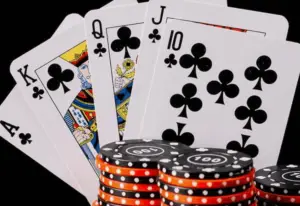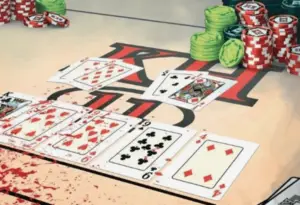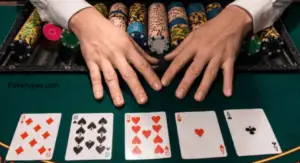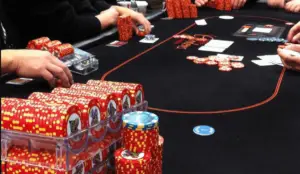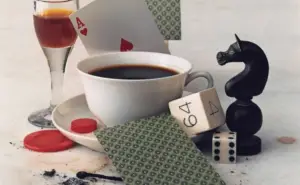Omaha poker has become popular among card sharks as a thrilling version of community card poker. Unlike Texas Hold’em, players get four hole cards instead of two, adding a whole new layer of excitement.
There are two main flavors of Omaha: Pot Limit Omaha (PLO) and Omaha Hi-Lo. In PLO, the biggest bet you can make is the size of the pot, while Omaha Hi-Lo splits the pot between the best high and low hands.
The key difference from Hold’em is that in Omaha, you must use exactly two of your hole cards and three community cards to make your hand.
This rule cranks up the action and makes for some wild swings. With more cards in play, Omaha hands tend to be stronger, so you’ll see more monster hands and big pots. If you’re looking to spice up your poker game, Omaha’s your ticket to a whole new world of card-slinging fun.
Fundamental Omaha Strategy Concepts
Omaha poker packs a punch with some key strategies that’ll give you an edge at the table. First up, position is king in this game. Being last to act lets you see what everyone else does before you make your move.
It’s like having X-ray vision into your opponents’ hands! For example, if you’re on the button and everyone checks on you, you can take a stab at the pot even with a mediocre hand.
Next, pay close attention to pot odds and your equity. This means figuring out if the money in the pot is worth chasing your draw. Let’s say there’s $100 in the pot and it costs you $20 to call. You’re getting 5-to-1 odds, so if your hand has better than a 20% chance of winning, it’s a good bet.
Drawing hands are the bread and butter of Omaha. You’ll often find yourself with tons of outs to make a killer hand. But here’s the kicker – always aim for the nuts. In Omaha, second-best hands are money losers. If there’s a flush draw on the board, you want the ace of that suit in your hand.
Remember, in Omaha you’re dealt four cards, so there are way more possible combinations than in Hold’em. This means you need to be extra careful about overvaluing your hand.
A pair of aces might be gold in Hold’em, but in Omaha, it’s often just fool’s gold. So keep these tips in mind, and you’ll be crushing the Omaha tables in no time!
Starting Hand Selection
Selecting the right starting hands can make or break your Omaha poker game. Let’s talk about the cream of the crop first. Premium starting hands are the big dogs you want to see. The absolute top dog is A-A-K-K double-suited, which means you’ve got two aces and two kings, with two different suit pairs.
This hand is a real powerhouse, giving you a shot at the nut flush and top set. Right on its heels is A-A-J-T double-suited, which might surprise you, but it’s got more straight potential than A-A-Q-Q.
Now, for playable hand combinations, you’re looking for connected cards that can make strong hands. Stuff like K-Q-J-T or J-T-9-8 can be gold if they’re double-suited. These hands can make the nut straight or a strong flush draw. But watch out! Not all hands are created equal in Omaha. There are some real stinkers you need to avoid like the plague. The absolute worst hand you can get is four-of-a-kind, like 7-7-7-7.
It might look cool, but it’s actually garbage because you can only use two cards from your hand. Other hands to toss in the muck are rainbow hands (all different suits) with no connection, like 2-5-8-J. These hands are about as useful as a screen door on a submarine.
Remember, in Omaha, you’re looking for hands that work together to make multiple strong combinations. If your hand doesn’t have that potential, it’s probably best to fold and wait for a better spot.
Pre-flop Strategy
When it comes to pre-flop strategy in Omaha poker, you’ve gotta be on your toes! First up, let’s talk about raising and 3-betting ranges. You want to be aggressive with your premium hands like A-A-K-K double-suited. Don’t be shy about pumping up the pot when you’ve got the goods!
For example, if you’re in a late position with a strong hand, you might want to raise to 3 or 4 times the big blind. Now, when it comes to limping, most pros will tell you to avoid it like the plague. But there are times when it can be sneaky smart.
If you’re in an early position with a hand that plays well in multi-way pots, like 7-8-9-T double-suited, you might want to limp and see a cheap flop.
Just don’t make it a habit, or you’ll be pegged as a weak player! Lastly, let’s chat about positional adjustments. Your pre-flop range should be tighter in the early position and looser on the button.
For instance, you might only play 15% of hands from under the gun, but up to 50% from the button. Remember, the position is power in Omaha! So, next time you’re at the table, keep these tips in mind.
Be aggressive with your good hands, be cautious about limping, and always consider your position. If you do, you’ll be well on your way to crushing the pre-flop game in Omaha!
Post-flop Play
First up, let’s talk about flop texture analysis. This is where you size up the board and figure out how it might’ve hit your opponents’ hands. For example, on a rainbow flop like K♦ 7♥ 3♠, you’re dealing with a dry board that’s tough to connect with.
But if you see something like J♣ 9♠ 6♥, that’s a connected flop where lots of straight draws are possible. Now, let’s chat about continuation betting strategy. In Omaha, you can’t just c-bet willy-nilly like in Hold’em.
You gotta be more selective because your opponents have four cards and are more likely to have hit something. On that K♦ 7♥ 3♠ board, you might wanna c-bet with a merged range, throwing in some bluffs with your strong hands. But on a wet board like J♣ 9♠ 6♥, you might wanna check back more often to avoid getting check-raised off your equity.
Lastly, let’s talk drawing hand management. In Omaha, you’re often gonna find yourself with a monster draw like a wrap (13 or more outs to a straight) or a nut flush draw.
When you’ve got these hands, you wanna play ’em fast and build a big pot. But be careful with weaker draws like gutshots or non-nut flush draws. These hands can get you in trouble if you overplay ’em. Remember, in Omaha, you’re always looking to scoop the pot, not just win half of it!
Turn and River Strategy
Pot control is all about keeping the pot size manageable when you’ve got a decent hand, but not the nuts. For example, if you’ve got top two pair on the turn, you might want to check back instead of betting to keep the pot small. This way, you’re not bloating the pot with a hand that could be beat. Now, let’s chat about bluffing opportunities.
The turn and river are prime spots for some sneaky plays. If a scare card hits on the turn, like an ace or a card that completes a potential straight or flush, you can represent that hand with a big bet.
But be careful – Omaha players love to call, so make sure your bluffs make sense! Lastly, let’s dive into value betting. This is where the big bucks are made in Omaha. If you’ve got the nuts or a very strong hand, you want to bet big to get maximum value.
For instance, if you’ve got the nut flush on the river, you might want to bet the pot to get called by weaker flushes or sets. Remember, in Omaha, players often have strong hands, so they’re more likely to call big bets.
Just be sure to size your bets based on your opponent’s tendencies and the board texture. If you keep these tips in mind, you’ll be crushing the turn and river in no time!
Advanced Omaha Concepts
When it comes to advanced Omaha concepts, you’ve gotta wrap your head around some tricky stuff. First up, let’s talk blockers. These are cards in your hand that make it less likely your opponent has a strong hand.
For example, if you’re holding the A♠ on a flush draw board, you know your opponent can’t have the nut flush draw. This can give you the confidence to bluff more often. Next, we’ve got wrap draws, which are like straight draws on steroids. A classic wrap is something like 9-8-7-6 on a 10-J-x flop. You’ve got a whopping 20 outs to make a straight! That’s way more than the measly 8 outs you’d have in Hold’em.
Now, let’s chat about stack-to-pot ratio (SPR). This is the size of your stack compared to the pot. In Omaha, you want a higher SPR than in Hold’em because you’re often drawing to the nuts. For instance, with an SPR of 5, you can comfortably get it all in with a nut flush draw.
But be careful! With a low SPR, you might find yourself committed with just top pair, which is often a disaster in Omaha.
Remember, in this game, the nuts change fast, so always be thinking about what the best possible hand could be. If you keep these concepts in mind, you’ll be crushing the Omaha tables in no time!
Omaha Tournament Strategies
In the early stages, it’s all about building your stack. Play those premium hands aggressively and look for spots to isolate weaker players. As the blinds increase, you’ll need to tighten up and focus on pot control.
Don’t be afraid to fold those marginal hands that might’ve been playable earlier. When you hit the bubble, it’s time to put the pressure on those short stacks. If you’re the one with the short stack, don’t panic! Look for spots to shove with strong drawing hands like A-A-x-x or double-suited connectors.
Remember, in Omaha, you’ve got more outs than in Hold’em, so those all-in moves can be more profitable. Once you make it to the final table, it’s a whole new ballgame.
Pay close attention to stack sizes and adjust your play accordingly. If you’re the big stack, use that chip advantage to bully the medium stacks. If you’re short, look for spots to double up with hands that have multiple ways to win.
And when it gets down to heads-up play, don’t be afraid to open up your range and play more aggressively. In Omaha tournaments, the key is to stay flexible and adapt your strategy as the game evolves. Keep these tips in mind, and you’ll be well on your way to crushing those Omaha tourneys!
Bankroll Management for Omaha
First up, let’s talk about recommended buy-in levels. For cash games, you’ll want at least 50 buy-ins for your chosen stake. So, if you’re playing $1/$2 Pot-Limit Omaha, you should have a bankroll of at least $5,000.
For tournaments, aim for 100 buy-ins. Now, let’s chat about dealing with variance. Omaha is a wild ride, with bigger swings than a playground! You might lose 20-30 buy-ins in a single session, so don’t freak out. It’s all part of the game.
To handle these swings, make sure you’re playing within your bankroll, and don’t be afraid to move down in stakes if needed. Speaking of which, moving up in stakes is where the big bucks are made. But don’t rush it! Wait until you’ve got at least 100 buy-ins for the next level before taking a shot.
For example, if you’re crushing $1/$2, wait until you’ve got $20,000 before trying $2/$5. Remember, patience is key in Omaha. It’s not a sprint, it’s a marathon! By following these tips, you’ll be able to weather the storms of variance and climb the stakes like a pro. Just remember, in Omaha, the nuts change fast, so always be on your toes!
Common Mistakes to Avoid
Some common mistakes can really trip you up if you’re not careful. First off, overvaluing non-nut hands is a big no-no. In Omaha, you’ve gotta be gunning for the nuts (the best possible hand) or you’re asking for trouble. For example, if you’ve got A♠K♠Q♣J♦ on a K♥7♠2♣ flop, you might think you’re sitting pretty with a top pair, but someone could easily have K-K for a set.
Next up, playing too many hands is a rookie mistake that’ll drain your stack faster than you can say “all-in”. In Omaha, you get four cards, so it’s tempting to play every hand, but that’s a one-way ticket to Bustville. Stick to hands with good connectivity and high card potential. Lastly, neglecting position is like shooting yourself in the foot.
In Omaha, the position is even more crucial than in Hold’em. Being on the button gives you a huge advantage, letting you see what everyone else does before you act.
So, tighten up your range in an early position and loosen up on the button. Remember, in Omaha, about 70% of pots are won by the player who bets or raises last. So, keep these tips in mind, and you’ll be crushing the Omaha tables in no time!
Transitioning from Hold’em to Omaha
When you’re making the jump from Texas Hold’em to Omaha, you’ve gotta rewire your brain a bit! First off, forget about those pocket pairs being gold – in Omaha, they’re often fool’s gold. You need to think about connectedness and suitedness way more. For example, a hand like A♠K♠Q♥J♥ is way stronger than A♠A♣7♦2♣.Hand reading gets trickier too.
Hold’em, you might put your opponent on a specific hand. In Omaha, you’re dealing with range of hands. It’s like trying to guess what’s in a big ol’ bag of marbles instead of just one marble!When it comes to equity realization, Omaha’s a whole new ballgame. In Hold’em, if you’ve got 60% equity, you’ll win about 60% of the time.
But in Omaha, you might only realize 40% of that equity. It’s like having a big slice of pizza but only getting to eat half of it!
Omaha Tools and Resources
If you’re looking to up your Omaha poker game, there are some killer tools and resources out there to help you crush it at the tables. First up, let’s talk about hand analyzers and equity calculators.
These bad boys are like having a poker pro in your pocket! Apps like PokerCruncher and Omaha Odds Calculator can give you the lowdown on your hand strength and odds in a flash. They’re perfect for studying tricky spots away from the table.
When it comes to training sites, Run It Once and PokerCoaching.com are the cream of the crop. These sites offer video lessons from poker pros like Phil Galfond and Jonathan Little. You can even play hands and get instant feedback on your decisions. Talk about leveling up your game!
If you’re more of a bookworm, there are some must-read Omaha books out there. “Pot-Limit Omaha Poker” by Jeff Hwang is like the Bible of PLO.
It’ll teach you the ins and outs of the game, from basic strategy to advanced concepts. For a more modern take, check out “Mastering Small Stakes Pot-Limit Omaha” by Fernando “JNandez” Habegger.
This book is packed with cutting-edge strategies that’ll have you playing like a pro in no time. Remember, the key to improving at Omaha is practice and study. So grab these tools, hit the books, and get ready to dominate the felt!
Conclusion
To crush it at Omaha Poker, you’ve gotta keep a few key things in mind. First off, be picky with your starting hands – not all four-card combos are created equal! Remember, position is power, so play tight when you’re first to act and loosen up on the button.
Always aim for the nuts or a draw to the nuts, ’cause second-best hands are money losers in this game. Don’t go crazy with the bluffing – it’s harder to pull off in Omaha than in Hold’em.
And for Pete’s sake, don’t get married to those pocket aces! But here’s the real kicker: you gotta keep learning and practicing. The game’s always changing, so hit up some training sites like PokerCoaching.com or Run It Once to stay sharp. Put in the work, and you’ll be stacking chips in no time!

